In 1980 conspiracy researcher Mae Brussell identified Robert Linkletter, son of the famous Hollywood entertainer and celebrity Art Linkletter as the Zodiac Killer. Brussell’s source of information was a letter from a woman who lived in Woodland Hills who knew Robert personally and also knew him as the Zodiac. Read more:
Mae Brussell on Directed Energy Weapons
by William Weston
General Curtis LeMay, like his friend Reeve Whitson, was “on the fringe of very far-out research for the government, not openly discussed because it was on the verge of the occult.” When asked by Barry Goldwater if there was any truth to the rumor that UFO evidence was in a secret storage room at Wright-Patterson Air Force base and, if true, could he have access to it, LeMay gave the Arizona senator “holy hell” and said, “Not only can’t you get into it but don’t you ever mention it to me again.”
Another area of exotic, far-out technology that LeMay knew a lot about was directed energy weapons, the subject of this article. On March 28, 1962, LeMay, as chief of staff for the Air Force, said the following during a speech at Assumption College in Worcester, Massachusetts.
“Our national security in the future may depend on armaments far different from any we know today. . . . Beam-directed energy weapons may be used in space, and the energy directed by these weapons could travel across space with the speed of light. This would be invaluable for the interception of ICBM ballistic weapons. We have looked into the phenomena associated with this kind of weapon. We have evidence the Soviets are also interested.”
Bem Price in an article for the Miami Herald entitled “Control of Outer Space Means Rule of the Earth” June 18, 1963, said “Beam-directed energy weapons may be used in space. And the energy directed to these weapons could travel across space with the speed of light. This would be invaluable for the interception of ballistic weapons.” According to Price, energy from the sun could be converted by satellite into amplified microwaves. The microwave beam can then go through the Earth’s atmosphere without loss of energy. On Earth this energy can be reconverted to electrical power, or light waves. The same microwave beam could also be used to incinerate ballistic missiles or “possibly cities.”
Beam-directed applications are chiefly of two types. The laser, which is an acronym for “light amplification by stimulated emission of radiation,” converts and concentrates the energy of diffuse multi-colored light into a beam of single-colored light of extraordinary intensity and energy. It can heat and burn things, not unlike sunlight through a magnifying glass. Concentrated through a ruby prism, a laser beam can drill a hole through a steel plate in a fraction of a second.
Masers amplify microwaves to generate free subatomic particles called electrons and concentrates them into a kinetic beam by means of a magnetic field. A microwave beam stimulates atoms and molecules in conductive materials such as iron, copper, or silver but no heat is produced. Think of a glass of water in an ordinary microwave oven. When turned on, the oven stimulates water molecules, creating a heated liquid, but the glass itself remains cool. Glass is not a conductor of electricity. After an extended amount of time, the glass will become hot, not because of the microwaves, but because heat from the water is transferred to the glass.
Research and development of directed energy weapons increased exponentially after March 23, 1983 when President Ronald Reagan called for an end to the old mutual assured destruction stalemate and urged scientists and engineers to find a way to make nuclear armaments “impotent and obsolete.” Thus began the Strategic Defense Initiative (SDI), otherwise known as “Star Wars.” The plan was to build and deploy around the globe hundreds of ground- and space-based platforms for laser and particle beam weapons to shoot down enemy missiles approaching the United States. Former director of the Defense Intelligence Agency Lt. General Daniel O. Graham expected SDI to become operational within five or six years. He believed that it could knock down Soviet missiles within five to seven minutes of being launched.
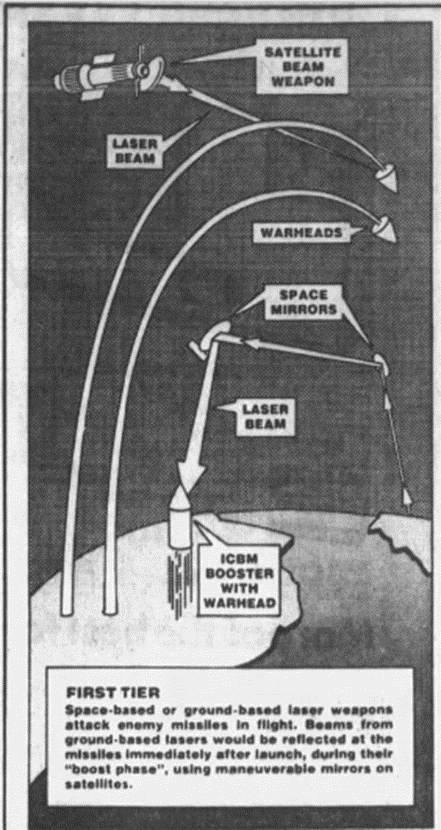
Artist’s conception of Star Wars Defense System
Not to be outdone, the Soviet Union was working on its own version of SDI. Columnist Jack Anderson on September 6, 1985 quoted CIA sources who said that a huge facility in Krasnoarmeysk, 30 miles northeast of Moscow, employed 10,000 scientists and engineers to build, test, and produce laser weaponry.
Notwithstanding the race to see which superpower could develop these new weapons first, White House officials, reporters, and news commentators predicted that SDI would eventually ease Cold War tensions by eliminating the threat of nuclear annihilation. Notwithstanding, the possibility existed that strategic defense weapons could easily turn into an offensive first strike force. The enormous amount of energy needed to blast fast-moving nuclear warheads at long distances could also be turned against enemy forces on the ground. Not only armies but even whole cities could be wiped out within minutes.
The terrifying possibilities of SDI were noted by Mae Brussell, on her weekly radio show, January 13, 1986:
There’s an article in the San Francisco Chronicle, a reprint of yesterday’s story in the L.A. Times by Robert Scheer. It’s titled “Laser Weapons can Burn Cities, Two Studies Warn.” It has to do with reports that have come out on the fact that the Strategic Defense Initiative, the Star War proposal, not only is to protect against Soviet missiles that are coming into the United States but it could also be an offensive weapon to cause massive firestorms throughout the world and cause tremendous damage to the air by burning every city in the Soviet Union, for example. One city after the other, one moment after the other, until they are all destroyed.
Below is Robert Scheer’s article:
Livermore, Calif. – Laser weapons being developed as part of President Reagan’s Strategic Defense Initiative could more easily be used to incinerate enemy cities than to protect the United States against Soviet missiles, according to an article in the current issue of a leading physics magazine and a separate study being circulated among government weapons scientists.
Many advocates of the “Star Wars” defense system hope lasers fired down from space stations or shot up from the Earth and reflected off space-based mirrors onto targets below may one day be part of a defensive shield against enemy missiles. But new analysis suggests that high-intensity laser light from such weapons could also be used offensively to unleash massive firestorms, possibly producing an environmental disaster similar to a “nuclear winter.”
Non-Nuclear Armageddon
The study, which was produced by R&D Associates, an influential defense think tank based in Marina del Rey, cites data indicating that, “in a matter of hours, a laser defense system powerful enough to cope with the ballistic missile threat can also destroy the enemy’s major cities by fire. The attack would proceed city by city, the attack time for each city being only a matter of minutes. Not nuclear destruction, but Armageddon all the same.”
Lasers “have the potential of initiating massive urban fires and even of destroying the enemy’s major cities by fire in a matter of hours,” according to the article by Caroline L. Herzenberg, a government physicist at the Argonne National Laboratory near Chicago.
“Such mass fires might be expected to generate smoke in amounts comparable to the amounts generated in some major nuclear exchange scenarios,” the article in the current issue of Physics and Society, a publication of the American Physical Society, warned. This could cause “a climactic catastrophe simitar to ‘nuclear winter,’” a reference to the disastrous lowering of the Earth’s temperature many scientists believe would result from a nuclear war.
The R&D study does not mention a “nuclear winter” but does stress that lasers are not intrinsically defensive weapons and can be used to start massive fires.
“The lasers can be employed in a manner not contemplated by the (Strategic Defense Initiative),” caution Albert L. Latter and Ernest A. Martinelli, who wrote the eight-page R&D Associates study and are highly regarded advocates of a stronger U.S. defense. “Specifically, they can be targeted against the same entities they were designed to protect: cities.
“After spending hundreds of billions of dollars, we would be back where we started from: deterrence by retaliation. Our cities would be hostage to lasers instead of nuclear weapons,’ the report said.
President Reagan has offered ultimately to share “Star Wars” technology with the Soviet Union. But the R&D Associates report suggests that such weapons in the hands of the Soviets might prove menacing: “A Soviet laser weapon system . . . powerful enough to defend against the U.S. ballistic missile threat can incinerate our cities without warning on a time scale of minutes-per-city; minutes to hours for the whole country. To deter such an attack, the U.S. could only threaten to retaliate.”
The authors suggested that laser weapons might also be used against Soviet conventional forces. “For those who have advocated limited nuclear options against the Soviet Union itself, limited laser options would produce less collateral damage and be just as effective otherwise,” they wrote.
The danger of laser-induced fires had not been much noticed by critics or proponents of the Strategic Defense Initiative until the appearance of the article and the R&D study. When asked to comment, a Strategic Defense Initiative spokeswoman stated on a non-attribution basis after checking with other officials that “lasers could start fires.” But she added that “this is not a problem that we are addressing at this time. It is not the intention of (the Strategic Defense Initiative) to start fires. This is an anti-ballistic (missile) program.”
She denied also that lasers designed for defense could be used as offensive weapons. “They would have to be designed differently to cause fires,” she said.
However, in an interview Friday, Herzenberg, the author of the physics magazine article, responded that “all you need is to dump enough energy on something and, if it’s flammable, it will go up. The free electron laser, the excimer laser, and the deuterium fluoride chemical laser (which are the subjects of current research) all can go through the atmosphere and cause fires.”
The free electron laser is being developed at the Lawrence Livermore National Laboratory here. However, lab spokesman Norris Smith said that “the lab will have no comment” on the matter.
Theodore A. Postol, until recently adviser on nuclear weapons to the chief of naval operations and an expert on the implications of firestorms, said, “If you were attempting to set fires with an optical laser that was already sufficiently powerful to attack hardened ICBM boosters, there is no question that such a device could also be used to create mass fires of enormous scale and ferocity – mass urban fires potentially larger and more intense than those created by the great incendiary raids on Hamburg and Dresden in World War II.”
As stated in the Scheer article, Lawrence Livermore Laboratory was the primary developer of the free electron laser (a microwave application). The following is from their Internal report for 65th Anniversary:
The Laboratory has a long history of advancing the technology of electron linear accelerators for scientific and national security applications. After ASTRON, the Electron Test Accelerator (ETA) was built to study electron beam propagation in air as a possible directed-energy weapon. Completed in 1983, the 10-times more energetic Advanced Test Accelerator at Site 300 furthered the study of beam propagation, and the beam was used as a pump for a free electron laser (FEL).
SDI was identical to the intent of German rocket scientists during World War II who conceived the idea of constructing and launching into space a large reflecting mirror to focus the sun’s rays onto any spot on the earth. “The focusing of this reflector,” Brussell said, “on any living person would kill them immediately. Ocean waters can turn to steam, and forest fires instantly kindled.”
Information regarding this weapon was publicly disclosed by Colonel John A. Keck during a press conference in Paris on June 28, 1945. From Clarence Lasby’s book Project Paperclip:
At a news conference in Paris, he spoke with pride about the capture and interrogation of twelve hundred “top-line” scientists, and told his audience of some of their most fantastic projects: a “sun-gun” that might harness the sun’s rays to demolish nations from a platform 5,100 miles in the sky; a cannon with a 400-foot barrel and a range of 82 miles; an apparatus that would fire rockets from under the sea. After relating that “Hitler almost made it” in his attempt to raise warfare to a new scientific plane, he offered a glance into the future. “These men of extremely practical and keen minds,” he reported, were “putting science ahead of nationality and volunteering to move to the United States and Britain to continue their work. . . .”
For with no especial concern about politics but with a great sensitivity for spoils, the technical intelligence officers had amassed a scientific treasure, and, in the words of one participant, “put it into good safe American territory for future distribution.”
Further details about the “sun gun” were given in Time magazine July 9, 1945:
Science: Sun Gun
The scene was Allied press headquarters in Paris on a rainy summer day. Facing the half-dozing correspondents, Lieut. Colonel John A. Keck, onetime Pittsburgh engineer and now chief of Allied technical intelligence on German weapons, began quietly: “This will make Buck Rogers seem as if he lived in the Gay ’90s.” He proceeded to unfold the improbable story of what German scientists were up to when V-E day interrupted them.
At a research center in Hillersleben a group of them were solemnly laying plans for a “space station” 5,100 miles up, from which a “sun gun” would have the whole earth at its mercy. Assuming that at that height a floating structure would be beyond the pull of the earth’s gravity, they proposed to build a platform for launching rockets into interstellar space and for harnessing the sun’s heat. By use of a huge reflector, like a burning mirror, they calculated that enough heat could be focused on a chosen area to make an ocean boil or to burn up a city in a flash. Their sun gun could also be used, they pointed out, to produce steam and electric power at global receiving stations.
German physicists had already figured out the sun gun’s necessary size (3½ sq. mi.) and composition (metallic sodium). Presumably they also had ideas about how the space station might be kept under control (it would have to revolve with the earth like a satellite) and be supplied with air for its inhabitants. Unperturbed by Allied officers’ skeptical cross-examination, the Germans coolly announced they were certain the thing could be done within 50 or 100 years.
Brussell continues:
There is one section of the book of Project Paperclip that always interested me – always – and it was the part about bringing in the scientists who would construct a space station. They were brought here from Germany – useful for launching space ships into the atmosphere. They would construct a large reflector for focusing the sun’s rays onto the Earth, and they had another objective, a terrible thing, a weapon that would enable the first person to strike to rule the world. The focusing of this reflector on any living person would kill them immediately. Ocean waters can turn to steam, and forest fires instantly kindled. . . .
[The book] tells how impressed the Americans were by the Germans being able to conceive of something that they could rule the world and scorch the Earth, that we brought these scientists, hundreds of them, over 600 of them, to the United States.
American technological know-how along with the mindset of men who wanted to rule the world and almost won the war was a dangerous combination. One of the items on their agenda was to start fires with directed energy weapons. According to Brussell:
I believe that fire down at Big Sur seven or eight years ago was an experimentation in this kind of kindling.
The Big Sur fire that burned for three weeks in August 1977 was actually preceded by a firestorm that occurred on Mt. Diablo, the devil’s mountain, 150 miles north of Big Sur and 35 miles east of San Francisco.
The last weekend of July 1977 was unusually hot with record-breaking temperatures reaching over 100 degrees. State parks at Mt. Tamalpais and Mt. Diablo were closed because of extreme fire danger. Welcome relief came on Monday morning, August 1, with cooling temperatures, rising humidity, and calm winds.
Shortly after 1:00 pm, mild weather turned surprisingly wild. People on the coast saw a low, dark cloud approaching from the west with exceptional speed. It was “a most unusual piece of weather,” according to the Santa Cruz Sentinel. The strange cloud brought gusts of wind and a sudden lowering of the temperature. Around 5:00 pm, it was followed by higher clouds of lightning and thunder. Described by several newspapers as a “freak lightning storm,” it rumbled over Northern California for about forty-five minutes, filling the sky with spectacular forks of lightning but bringing negligible rain, only a few drops here and there.
“I’ve never seen lightning like this before,” said Marie Simpson who lived near Mt. Diablo. “Usually the lightning is just a flash but this time you could see the shape of it, it was so close.”
Peggy Hutting, a resident living in Clayton (a rural community near the foot of Mt. Diablo with a population of 2,500), speaking to a reporter for The Concord Transcript, said that around 6:00 pm, she saw and heard at a distance of about a mile a lightning bolt strike the top of Mt. Zion, sparking a blaze among the brush. “It started as a little dinky fire,” said Rick Zerphey. “Then it started to spread fast and was burning toward us. I thought it was going to get some of the homes here.” With flames burning chaparral three to five feet high, in all directions, and billows of smoke rising upward, it spread to Mt. Diablo. As the blaze climbed the slope, flames forty feet high shot up from the mountain. One awed spectator said it looked like a volcano with lava pouring out.
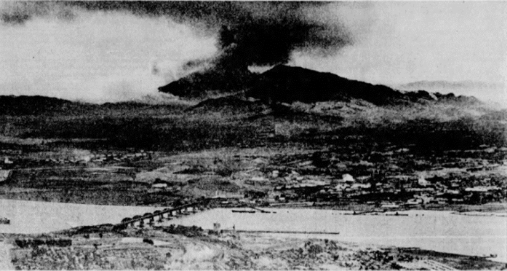
Mt. Diablo, early evening, August 1. Aerial view from across Carquinez Straits at Martinez.
In the nearby community of Walnut Creek, twelve miles away, witnesses saw “a huge orange ball of fire” bursting upward and lighting up the sky. Adding to the spectacle was another lightning storm that rolled in around 9:00 pm and lasted until the next morning.

From Contra Costa Times August 5. Shading represents burned areas.
Among the spectators in Clayton were many from out of town, some of whom came from as far away as Oakland and San Jose (a forty-minute and an hour-and-fifteen minute drive, respectively). The local police chief was probably exaggerating when he said, “It looked like there were a 100,000 people there last night.” According to The Concord Transcript, “Just after the first reports of the fire were broadcast over Bay Area radio and television stations yesterday evening, thousands of people began clogging the streets of Clayton, blocking fire equipment and firefighters from reaching the scene. Frustrated law enforcement officials tried to turn back the hordes of ‘rubberneckers,’ who were trying to get as close as possible.”
It is strange that incoming spectators suddenly dropped whatever they were doing and rushed over to Clayton. Brush fires are common occurrences in California, especially during the months of July and August. Yet they jammed the streets of Clayton until well after midnight.
I believe that some of these fire watchers had prior knowledge that something unusual was happening at Mt. Diablo. Assuming that a spot was chosen to demonstrate the power of energy-directed weapons, the devil’s mountain on August 1 was a good place and time to do it. Probably among the cognoscenti were those who knew weather modification techniques to create electrical storms and direct a selected number of lightning bolts to strike designated spots.
Mt. Diablo burned through the night and into the next day. The fire was contained on August 4, after consuming 6,000 acres.
The lightning storms of August 1 lasted until well past sunrise the next day, touching off forty or fifty blazes throughout Northern California – from Lake Cachuma near Santa Barbara all the way to the Spanish Flats in Humboldt County. The vast majority of these were small, one- to ten-acre blazes, but a few became major conflagrations. Among them was a 1,000-acre blaze in the Marble Peak region twelve miles south of Big Sur. Another was a 200-acre blaze in the South Ventana Cone area six miles east of Big Sur. The latter was in a wilderness of rough, mountainous terrain 1200 to 4800 feet high.
Another dry lightning storm the following night considerably augmented the total number of fires. By Wednesday morning, state forestry officials counted 400 lightning-caused fires, six of which were major blazes. The map below shows their locations:
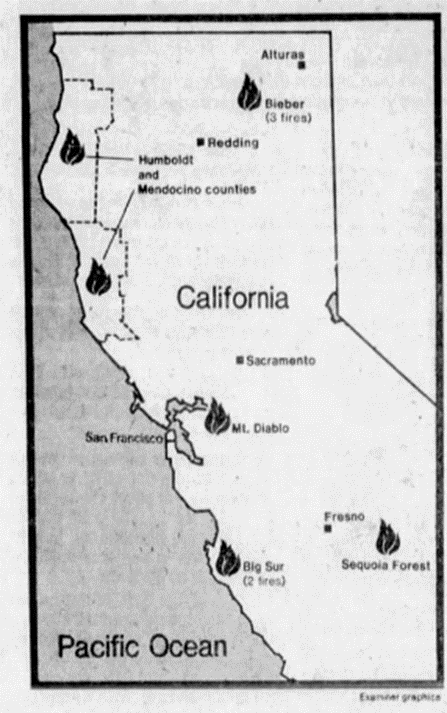
The two fires at Big Sur grew so rapidly that by Thursday morning they merged into one mammoth fire of 45,000 acres, making it the biggest of ongoing fires. It created a thick cloud of smoke that was between the elevations of 4,000 to 11,000 feet and stretched over the San Joaquin Valley and the Sierra foothills. Through the smoke the sun had an orange-red color.
The second biggest fire was located in Modoc County in the northeastern part of the state near the border of Oregon. Seven lightning-caused fires merged into one big fire. Nicknamed “Scarface” after a famous Native American chief of the Modoc tribe, the Scarface fire would ultimately burn 82,000 acres by the time it was contained on August 10.
A containment ring around the Big Sur fire was completed on August 18 and five days later the last flames were finally put out. The total acreage burned: 175,000 acres. Fortunately hardly any lives or homes were lost.
The Big Sur fire was in 1977 the second largest in California history exceeded by the Matilija fire in 1932 which had 220,000 acres. In the year 2023, the Big Sur fire is now down to the number 20 spot, due to eighteen gigantic fires that occurred in the last twenty years.
Brussell continues:
Last year when there were these huge fires in Florida and in the Southeast part of the of United States, I was very suspicious of the circumstances and believe that the government was testing those lasers at that time.
The testing of the lasers, both light- and microwave-amplified, would have occurred during a three-day surge of lightning-caused fires in the state of Florida beginning on Thursday, May 16, 1985. Thursday was the final day of a heat wave that brought record-breaking temperatures in the mid-90s. A few scattered clouds were in the sky, but otherwise it was mostly sunny.
The weather became unexpectedly weird around 6 pm, when a cold front brought an intense electrical storm with a lot of lightning but negligible rain over the east coast. For about forty-five minutes it caused power outages and brush fires in places like Titusville and Fort Pierce. The storm advanced to the west coast, where it caused more power outages and brush fires in places like Charlotte County. In every case the power outages were soon resolved, and the fires were quickly contained and extinguished. Weather forecasters predicted the same kind of weather for the following day: sunny skies, wind speed 10 to 15 mph, scattered thunderstorms in the afternoon.
Just after midnight, a lightning bolt started a fire in Broward County two miles northwest of the intersection of US 27 and State Route 84. It burned several acres of sawgrass by the time six forest rangers got there at 5 am. They noticed that the wind was driving it toward the Andytown substation, which belonged to Florida Power and Light. They estimated that it would be around 1 pm by the time it got there.

Raging brush fire near power lines at the intersection of US 27 and SR 84 after causing the blackout. From Miami Herald, May 18, 1985
The substation was a critical node in the power grid. Three major transmission lines converged at this point. Two of them originated from a power plant in Brunswick, Georgia, 400 miles away. The third started from a plant on Tampa Bay, went through Fort Myers, and extended across the Everglades to Andytown. Altogether the three lines brought 2,000 kilowatts of power, enough to supply one-fourth of the electrical needs of South Florida.
By mid-morning a sudden increase in wind velocity accelerated the spread of the fire, so that the amount of burnt sawgrass had grown rapidly to 3,000 acres. Warned of the dire circumstances by the forestry service, FPL sent a team of experts to assess the situation. Upon their arrival at 11 am, they saw that the fire was almost underneath the power lines. They called for a backup supply of electricity to be produced immediately by generators located in Fort Lauderdale and Port Everglades.
Utility workers turned on the machines at 11:43. “Three minutes later,” according to Larry Taylor, an FPL spokesman, “about half the time the emergency turbines needed to reach operating speed the fire shorted the lines.”
A resident who lived in the area of Andytown, Lou Hendric, said: “At the time of the blackout there was a large blast. It shook the house – all the power and phones went out immediately.”
“It looked like a lightning strike,” Larry Taylor said, while at the same time making it clear that it was not caused by lightning. Another FPL spokesman John Tamsburg said, “Electricity was arcing between the lines like a lightning bolt striking and then it popped like a howitzer going off.” The official explanation was that hot smoke and gases from the fire not only heated up the power lines but also created a conduit by which a giant spark could travel.
Taylor said, “The surprising thing about the blackout was that the heat of the fire simultaneously affected three major transmission lines each 95 feet above the ground and 90 feet apart from one another.” L. J. Snipes, an FPL spokesman, said, “Usually we can afford one line not operating and still not disturb the system but we can’t do it when all three lines go down. Also it was surprising that the fire moved so fast and covered the large area between the lines with enough intensity to short them all at once.”
Blowing three key transmission lines simultaneously with only three minutes to spare before the emergency generators kicked in seems a bit much for Mother Nature to handle. A better explanation is sabotage, under the cover of a wildfire, started by arsonists, and not by lightning.
The blackout affected 4.5 million residents living in Miami, Fort Lauderdale, Boca Raton, Delray Beach, Boynton Beach, and various other cities. Newspapers were full of stories of motorists stuck in traffic jams, women delivering babies in darkened hospitals, and people stranded in elevators. The power outage ran from Royal Palm Beach in Palm Beach County all the way south to the city of Marathon located in the Keys, a distance of 180 miles.

Replacement inputs of electricity came from Georgia, Alabama, Mississippi, and Louisiana. By mid-afternoon, 90 percent of customers had their service restored. At the same time, the fire at Andytown diminished so that utility workers could repair the damage.
While people in the cities were coping with the challenges of no electricity, an eruption of “lightning-caused” wildfires popped up in rural areas all over the state from the Panhandle to the Keys. The vast majority of these were small. Some became major fires driven by “very erratic winds,” gusting up to 42 and 60 mph. The worst threat in the state came along a 100-mile stretch from St. Augustine to Cape Canaveral, where seven or eight fires were forcing mass evacuations. The map below shows the counties where fires occurred:
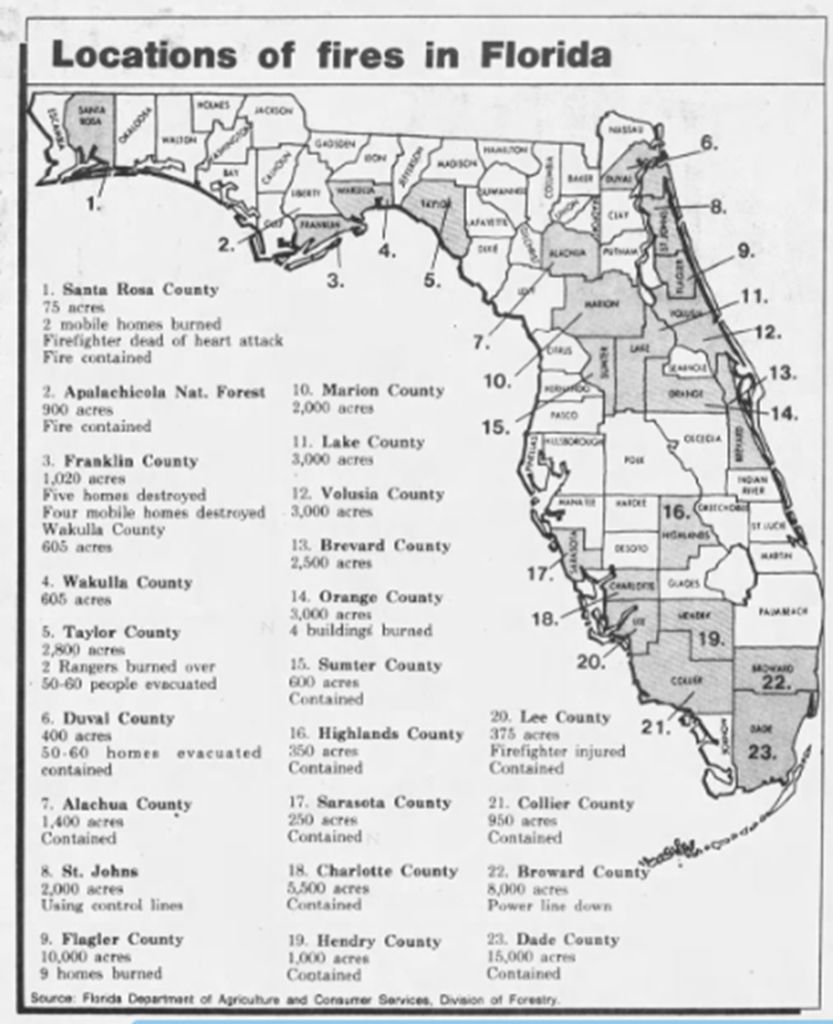
Mae Brussell suspected that the real cause of these fires was Star Wars weaponry. If so, then the blackout might have served to divert electrical energy to secret installations operating these weapons.
The most devastating fire occurred at a community of about 7,000 people in Flagler County, 25 miles south of St. Augustine. Palm Coast was the name given in 1969 to a super-subdivision tract that International Telephone and Telegraph planned to build and sell. Surrounding the community were dense stands of slash pine that had to be cleared. The company projected that the new city would eventually have a population of 750,000 by the year 2000. By the mid-1970s the much ballyhooed image of Palm Coast as “the most completely master-planned community in the world” suffered adverse publicity due to shoddy housing construction, environmental concerns, lawsuits alleging kickbacks and payoffs, along with federal intervention into ITT’s sales methods.
Friday afternoon, May 17, 1985, later to be remembered as Black Friday, two large forest fires broke out in Flagler County. Driven by gusty winds they splintered into dozens of smaller infernos. One swept through Korona, south of Bunnell, en route to the Intracoastal Waterway. Another swept eastward toward Palm Coast. A downed power line and approaching fires forced the closure of Interstate 95 and US Highway 1 for a distance of 32 miles, leaving no access into or out of the county. A melted toll line cut outside telephone communication for the entire county from about 3 pm Friday to 3 pm Saturday. Citizens trying to find out what was going on turned on their radios, only to find that the local radio stations continued to play rock and roll music when they should have been devoting the airwaves to emergency information.
Wildfires ripped through the woodsy Pine Lakes and Belle Terre sections of Palm Coast in a manner resembling “napalm strikes.” People barely had time to escape the flames. In half an hour the fire travelled three to four miles through the southern part of the city.

An expensive home in Pine Lakes subdivision of Palm Coast is reduced to rubble. Note the unburned foliage of nearby trees.
John Brink, a volunteer fireman, said on Saturday night. “When it started it was about 400 feet wide and now it’s 2 or 3 miles wide. I have never seen fire move so fast.” Brink further said that the fire was so hot that it created its own windstorm. “If you’ve ever heard a tornado, that’s what it sounded like. It was like a scream.”

Only the concrete walls of these two Palm Coast homes remain.
Another firefighter David Clegg said he saw a house near the Belle Terre Middle School become so hot that it exploded. Flaming debris sailed over the school and into another section of the neighborhood, where it started another raging fire.

Severed power pole in Palm Coast. FPL estimated 300 to 350 power poles were brought down by the fire. Note how the fire burned only the end of the pole. This is probably where some piece of metal was attached. In the background is a burned out car where a garage once stood.
Meanwhile, Florida Highway Patrolmen, National Guardmen, and sheriff’s deputies ordered immediate evacuations and blockaded the roads to keep people from going back into the city. Many residents staying in emergency shelters anxiously worried about their homes.
By Saturday night the rampaging fires began to calm throughout the state due to rising humidity and slowing winds. A total of 131 homes in Palm Coast were destroyed. Most of them were built since 1972 in the sprawling woodsy area developed by ITT. Many stately homes were reduced to mounds of powdery white ash laying on concrete slabs girdled with cinder blocks. Gutted cars abandoned by fleeing homeowners were parked in the wreckage of garages. In several places burned out houses stood only a few feet from those untouched by flames. Scorched yards lay adjacent to yards with green grass, shrubbery, and blooming flower gardens.
In spite of the massive firestorm, the small town of Palm Coast survived and is now a thriving city with a population of about 90,000 people.
A similar kind of firestorm happened to the city of Lahaina on the island of Maui. The picture below shows the aftermath. The main road on the left is Front Street.
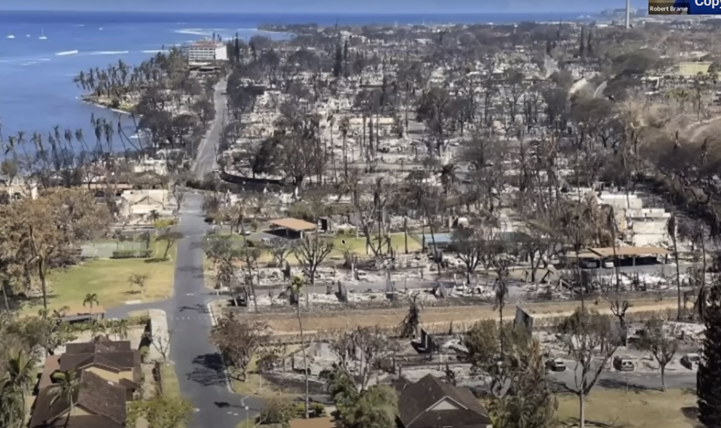
Events leading up to the fire began when a high pressure zone to the north and Hurricane Dora to the south generated strong gusty winds exceeding 80 mph. At 6:37 am, August 8, 2023, a downed power pole sparked a blaze in dry grass across the street from Lahaina Intermediate School on the northeast side of town. Fire crews from the Maui County Fire Department quickly responded and began dousing the flames. By 9:55 am the fire was fully contained.
The winds continued to blow, however, and flames flared up again at 3:30 pm, growing rapidly in size and intensity. Hundreds of homes went up in smoke. Moving in a southwesterly direction, the fire jumped over Highway 30 and at 4:46 was entering the main part of the city, forcing people to flee for their lives. They had no advance warning, because for some reason the civil defense sirens (a total of eighty around the island) were not activated. Police blocked Front Street at the north and south egress points, thus stopping cars from exiting the city. Bumper to bumper traffic ensued. By 5:45 the fire reached the shoreline. Cars immobilized by the traffic jam caught fire or exploded. Many people abandoned their vehicles and leaped into the ocean to escape the flames.
Communication networks were severed. Maui County Facebook posted an emergency message at 8:40 pm, apparently unaware that their messages were not getting through. Twenty minutes later someone added the comment: “You do not realize that all communication to Lahaina is cut off and nobody can get in touch with anyone on that side.”
Fire crews were still dousing hotspots ten days later. An extensive search turned up a total of one hundred confirmed deaths, although there were probably many more. It would not be until late September when residents could return to their city.
Forensic arborist Robert Brame saw pictures of Lahaina and recognized similarities to fire aftermaths he had seen in California. He personally visited thirty-eight locations and learned to tell the difference between natural and unnatural wildfires.
Normally, burning trees and bushes lose their leaves and many of their branches. Trunks become blackened and charred. Wooden structures such as houses and sheds often have exposed and blackened timbers. Non-flammable things such as tin roofing, pipes, toilets, and sinks are intact and covered with black ash and soot.

Aftermath of fire on west slope of Mt. Diablo, from Oakland Tribune August 4, 1977. This is an example of a natural, heat-ignited fire with bare and blackened trees and brush.
With unnatural fires, trees and bushes are generally unmarked by flames. Houses are either completely destroyed or completely undamaged – hardly any variations in between. The interior of burned down buildings have a lot of ash that is almost entirely white. Anything outside such as wooden fences, plastic toys and trash cans, rubber hoses, or discarded paper plates and bags do not burn. Below is a wooden fence from the Redding fire 2018. The rails fell off the posts along the whole fence line. Note the burn spots where the nails attached the rails to the posts.

The house below shows the effects of an unnatural fire in Lahaina:
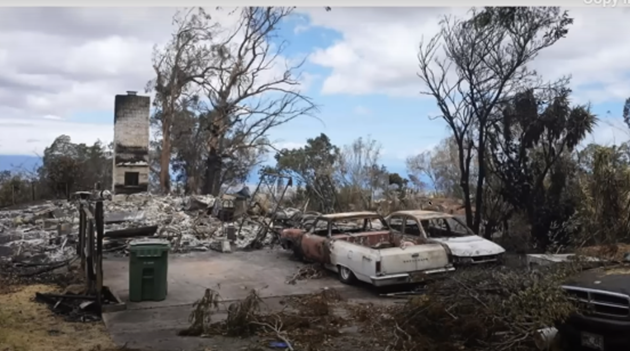
With the exception of the chimney, the house has been rendered into a pile of white ash and broken debris. The trash container out front did not become a melted puddle of plastic. There is a sharp dividing line between the burnt front half of the Chevy El Camino and the unburnt rear half. Brame guessed that a fire truck arrived and put out the flames before the car was completely consumed.
The next picture shows a vehicle that suffered an explosion so terrific it blew the door handles off. In the background is a burned down house and an unburnt house just behind it. A long row of eucalyptus trees appears unharmed.
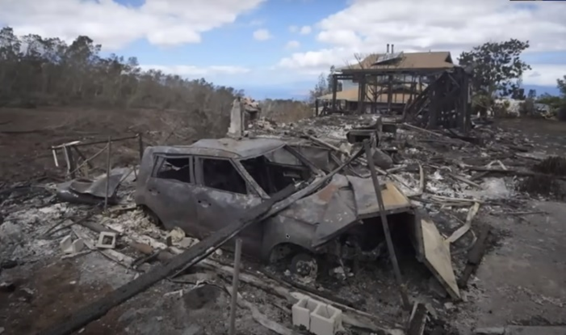
Below is a picture of melted window glass in a car.
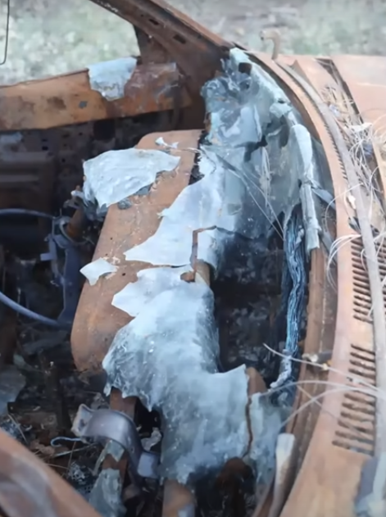
Auto glass melts at 2,500 degrees. The maximum temperature of wildfires is between 1,400 to 1,500 degrees. The discrepancy further indicates the unnatural character of the blaze.
Devastation is all around the giant banyan tree below.

In Lahaina, highly flammable palm trees are untouched but nearby homes and cars are totally destroyed, as seen below:
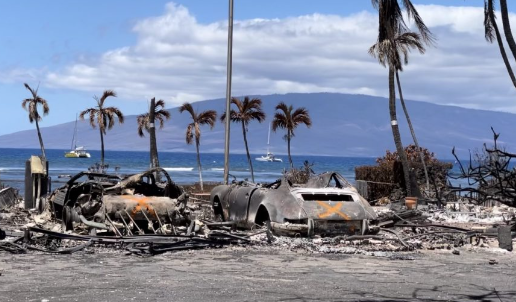
Typically a tree that appears to have survived did not really survive. Water inside the tree becomes so hot it actually cooks it from the inside out. Consequently, a healthy looking tree may either be dead or dying.
Brame first began investigating wildfires after he saw pictures of the huge Tubbs fire that destroyed thousands of homes in Santa Rosa, California in October 2017. The Department of Forestry and Fire Protection determined the cause to be “a private electrical system adjacent to a residential structure.
Brame made a personal trip to Santa Rosa and spent eight hours making observations. He was surprised by how few trees and plants inside the city suffered fire damage. The burnt ones were usually in close proximity to a burned down building – ten to fifteen feet, at the most. Nothing he saw made sense to him.
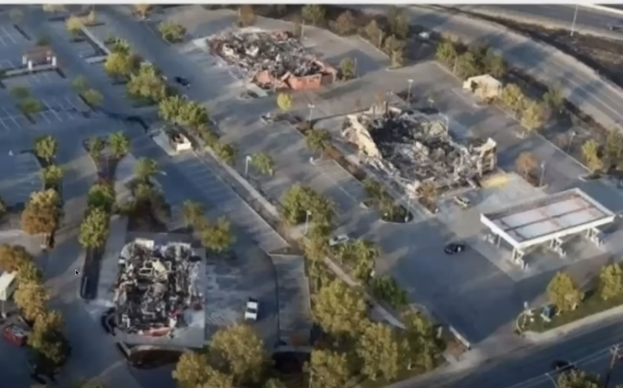
The picture above shows three destroyed restaurants and an intact gas station in Santa Rosa on Hopper Avenue. Apparently, the fire jumped over six lanes of Highway 101 to reach this spot. Arby’s is on the left, MacDonalds next to the gas station, and an Applebees at top center. The trees still have their foliage. Even the ambient heat emanating from the burning buildings apparently did not affect them.
Brame spoke with two fire captains, John Lord and Matt Dakin, who were also mystified by the Tubbs fire. According to Dakin, “The hottest a forest fire would ever get is 1,500 degrees Fahrenheit. In like manner, the hottest a house fire can get is 1,500 degrees. When porcelain toilets are made, they are fired in a kiln at temperatures between 2,381 and 2,455 degrees. It is impossible for a toilet to be immolated in a house fire.” Yet the toilets of Santa Rosa disintegrated into a powdery dust. You can see Dakin’s and Brame’s videos here and here.
Only one theory seems to fit the facts: a directed microwave beam coming from the sky. If that is so, then the expert opinion of Brame, Lord, and Dakin can be applied to dozens of other places with similar anomalies, such as the California fires in Redding in July 2018 and Paradise in November 2018; Lahaina in August 2023; Athens, Greece in August 2023; and of course the much earlier one in Palm Coast, Florida in 1985.
In the mid-1980s much was said by the military and the news media to convince the American public that the multi-billion dollar project of Star Wars was an essential investment to keep the United States secure from enemy attack by nuclear-armed intercontinental missiles. Not mentioned except by a few scientists in obscure publications was the awesome potential of space-based directed energy weapons to be turned against urban populations. Mae Brussell immediately recognized the old fascist dream of conquering the world that hid behind SDI’s facade of defensive warfare. It is ironic that American-made weapons, sold to the public as a national security measure, would have the most disastrous consequences on the American people for whom they were ostensibly designed to protect.
The DOD report below from 2003 anticipates complete usage by 2025.
Directed Energy Weapons on the Battlefield: A New Vision for 2025
My thanks go to Peter Heitmann for helping me with the research of this article.